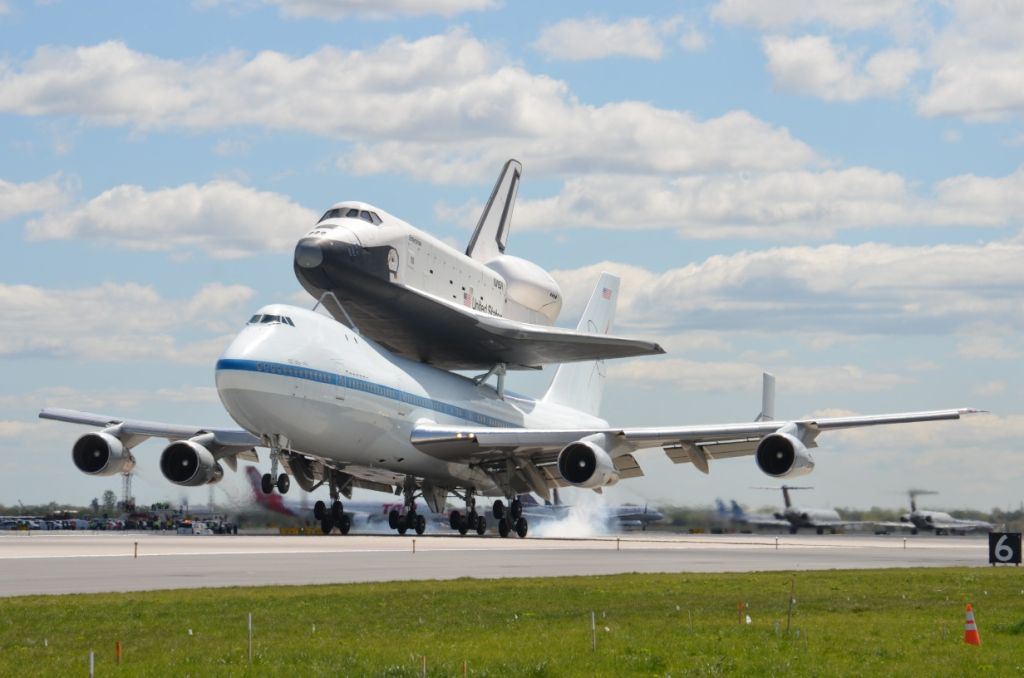Space Shuttle Enterprise Lands in NYC for Museum Display

This story was updated at 1:25 p.m. EDT on April 27.
NEW YORK, NY — Space shuttle Enterprise, the prototype for NASA's storied orbiter fleet, is now a New Yorker.
The original test space shuttle, Enterprise flew into the Big Apple on Friday (April 27) atop a modified Boeing 747 jumbo jet. The air- and spacecraft duo touched down at New York's John F. Kennedy (JFK) International Airport at 11:22 a.m. EDT (1522 GMT) following a photogenic flyover of some of the metropolitan area's most famous sights, including the Statue of Liberty and the Intrepid Sea, Air and Space Museum, which Enterprise will soon call home.
"Today is a great day for New York," said Senator Chuck Schumer (D-NY), who was on hand at JFK to watch the orbiter touch down. "Welcome, Enterprise — you're going to love it in New York, and we're glad to have you."
Enterprise, mounted to NASA's Shuttle Carrier Aircraft (SCA), took off from Dulles International Airport in Washington, D.C. at 9:39 a.m. EDT (1339 GMT). The nearly two-hour flight had been delayed for several days due to weather concerns.
The ferry flight marked the first time Enterprise had been airborne in more than a quarter-century. The prototype orbiter — which never flew in space but was used for a series of approach and landing tests in the late 1970s — had been a part of the Smithsonian National Air and Space Museum's collection since being flown to Washington in November 1985. [Photos: A Space Shuttle Called 'Enterprise']
On April 19, Enterprise was replaced at the Smithsonian's Steven F. Udvar-Hazy Center in Chantilly, Va., by Discovery, NASA's most-flown space shuttle. Friday's flight to New York began Enterprise's journey to the Intrepid, a converted World War II aircraft carrier, for its permanent display.
Get the world’s most fascinating discoveries delivered straight to your inbox.
Planes, cranes and barges
Enterprise's final landing was witnessed by an audience of 1,500 invited guests, including New York state and local elected officials. A brief handover ceremony between NASA and Intrepid staff was to be held at the airport. The space agency already turned over Enterprise's title to the museum last December.
"While New York is getting the space shuttle today, I must admit this is bittersweet for NASA, because we are saying goodbye to it," said NASA deputy chief Lori Garver.
Now on the ground in New York, Enterprise and the Shuttle Carrier Aircraft will remain mounted together at JFK until NASA can move and set up the two large cranes that joined the two vehicles in Washington. Once separated, Enterprise will be parked in an airport hangar for several weeks.
On June 4, Enterprise will be hoisted onto a specially configured barge and towed down the Hudson River to a dock in Bayonne, N. J. Once there, the space shuttle will be transferred to another barge outfitted with a large crane.
The crane-equipped barge will then complete the trip with Enterprise up the Hudson on June 6, pulling up next to the Intrepid and offloading the orbiter onto the museum's flight deck. A climate-controlled structure made of steel and fabric will then be erected over the shuttle beginning on June 7.
The Intrepid plans to open its new "Space Shuttle Pavilion" to the public on July 19. Inside, guests will find Enterprise displayed as if it were landing from one its test flights, its nose raised into the air and tailcone attached at its rear.
The flight deck exhibit, however, is intended to be temporary. Over the next few years, the Intrepid has plans to build a Science and Technology Center, which will become Enterprise's permanent home.
Ship and shuttle's space history
Enterprise and the Intrepid both played important but supporting roles in NASA's human spaceflight efforts.
Originally called the "Constitution," Enterprise got its name after fans of the sci-fi TV series "Star Trek" staged a successful write-in campaign.
The first of NASA's orbiters to roll off the assembly line, Enterprise is best known for the nine-month Approach and Landing Test (ALT) program, which demonstrated that a spacecraft that launched like a rocket could fly in the atmosphere and land like an airplane, except without power-gliding flight.
In addition to ground tests and captive flights (during which Enterprise remained atop its carrier plane), two astronaut crews took turns flying the 150,000-pound (68,000-kilogram) spacecraft to free-flight landings.
After the ALT program ended, Enterprise was used as a test and fit-check vehicle for the space shuttle program's ground processing facilities and two launch pads — Kennedy Space Center's Complex 39 in Florida and the planned but never used SLC-6 at Vandenberg Air Force Base in California.
Enterprise also became the only space shuttle to fly overseas, visiting the Paris Air Show as well as Germany, Italy and England before returning to the U.S. — and flying over New York City — in 1983.
As for the Intrepid, prior to becoming a museum in 1982, it served as the primary recovery ship for two of NASA's early manned spaceflights.
The Intrepid returned to land Scott Carpenter and his Aurora 7 Mercury spacecraft after the United States' second manned orbital flight splashed down 50 years ago this May. The aircraft carrier also recovered the first two-man crew of the Gemini program after that spacecraft landed in March 1965.
Replicas of both spacecraft are on display as part of the Intrepid's space exhibits.
Visit shuttles.collectspace.com for continuing coverage of the delivery and display of NASA's retired space shuttles.
This story was provided by SPACE.com, a sister site to LiveScience. Follow collectSPACE on Facebook and Twitter @collectSPACE and editor Robert Pearlman @robertpearlman. Copyright 2012 collectSPACE.com. All rights reserved.





